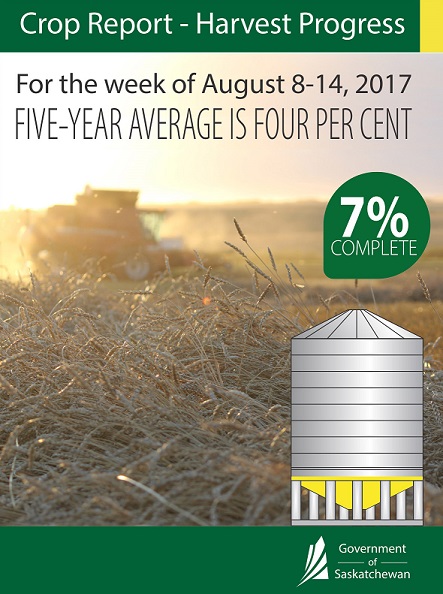Released on August 17, 2017
Despite rain delays in some areas, producers in the province now have seven per cent of the crop in the bin and seven per cent swathed or ready to straight-cut. The five-year (2012-2016) average for this time of year is four per cent combined and six per cent swathed or ready to straight-cut, according to Saskatchewan Agriculture’s Weekly Crop Report.Eighty-two per cent of fall rye, 50 per cent of winter wheat, 35 per cent of lentils, 28 per cent of field peas, three per cent of durum and two per cent of mustard are now in the bin. Six per cent of canola and five per cent of mustard have been swathed.
Harvest progress is most advanced in the southwest region where 17 per cent of the crop is now combined. The southeast region has 11 per cent combined, the west-central region three percent and the east-central region one per cent. Many producers in the north expect to be in the field in the coming weeks, although desiccation and swathing has begun in some areas.

Topsoil moisture continues to improve for many areas with the recent rain. Across the province, topsoil moisture on cropland is rated as one per cent surplus, 42 per cent adequate, 38 per cent short and 19 per cent very short. Hay land and pasture topsoil moisture is rated as one per cent surplus, 32 per cent adequate, 35 per cent short and 32 per cent very short.
Rainfall last week ranged from trace amounts to 48 mm in the Turtleford area. While the rain has been welcomed in some areas to help crops fill, it is too late to be of benefit in more southern areas where crops are rapidly drying down or have already been combined.
The majority of crop damage this past week is attributed to hail, localized flooding, lack of moisture and insects such as diamondback moths in canola.
Producers are busy combining, desiccating crops and hauling bales and grain.
For a complete Weekly Crop Report, visit http://www.publications.gov.sk.ca/redirect.cfm?p=86587&i=100255.
Follow the 2017 Crop Report on Twitter at @SKAgriculture.
-30-
For more information, contact:
Shannon Friesen
Agriculture
Moose Jaw
Phone: 306-694-3592
Email: shannon.friesen@gov.sk.ca
